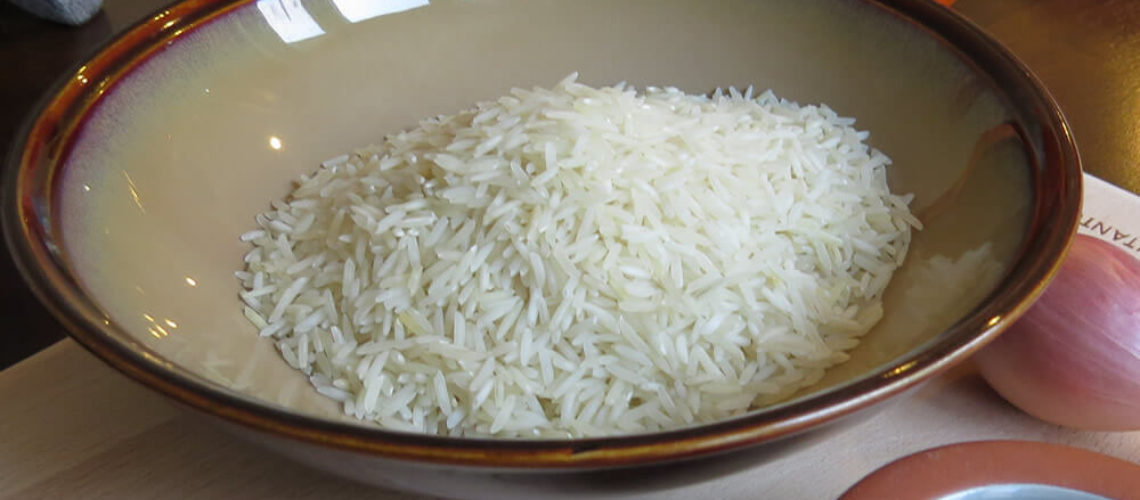TL;DR
- Measure, wash and drain the rice;
- Heat olive oil in sauce pan;
- Optional – Add diced onions and stir until pieces become semi-transparent;
- Add rice to sauce pan;
- Stir until rice starts to stick to bottom;
- Add hot water until it reaches approximately 1 1/4 inch (3cm) above rice level;
- Add salt;
- Bring to a boil in high heat;
- Lower heat to medium;
- Cover sauce pan leaving room for steam to escape;
- Rice will be done when water has fully evaporated;
Have you ever looked at a cow and thought how much simpler life would be if people could just eat grass?
What, you haven’t? Well I can assure you our ancestors did when they started agriculture because that’s exactly what rice is – fancy grass seeds. It’s as close as we’re ever going to get to eating actual grass.
Rice is a staple in so many cultures that pretty much all of them have some sort of rice recipe.
Choosing White Rice
Rice is all the same, right? Wrong. There’s all sorts of rice colors, shapes and flavors. In Brazil we just call the every day rice ‘arroz branco’ – white rice. It can be parboiled or not. Parboiled rice, according to Wikipedia, is rice that has gone through a process of pre-boiling while still in the husk. Restaurants use it a lot. At home, we do not. In fact, we hate the stuff. Avoid it if you can.
When we moved to Canada, the first thing we needed to adapt to was the lack of our type of rice. Fortunately there’s no shortage of Asian foods (South, East or otherwise) here, and we found that Basmati rice is very similar to ours in regards to the flavor and cooking process. We also experimented with Jasmine rice, which is really good, and use that on occasion.
Preparation
Before you do anything else, put on a kettle of filtered water to heat. We’ll be using it later. Note that you should never add cold water to hot food as it interrupts the cooking process and things may go awry. If it starts boiling, you can shut it off. If it hasn’t boiled by the time you need to use it, no problem.
Now that we know which rice to use, we need to figure out how much of it. Rice will absorb water while cooking, with the grains becoming larger as a result. Rule of thumb, we use between 2/3 to a full tea cup of rice for two people. That or 2 handfuls. Of course that’ll vary depending on the size of your hand, but unless you’re as big as Andre the Giant, it shouldn’t vary that much.
Next up is rinsing the rice. Put it all in a large bowl and add plenty of filtered water so you can easily stir it around with your hands. You’ll see the water become opaque. Strain it using a strainer or just drain the water while carefully blocking any rice from falling from the bowl. Repeat the steps a couple of times until the water comes out clearer.
If you don’t want to use unions in your rice, you can skip this part, as the rest of the process is identical.
Otherwise, now is the time to dice your onions. If you’ve never diced onions before, Gordon Ramsey has a quick tutorial. It’s not exactly how I do it but hey, all’s well as long as you keep your fingers intact.
Drizzle about 2 table spoons of olive oil onto the sauce pan and set it on medium-high heat. If you don’t have a sauce pan, use any other pot that has straight walls. Avoid using a wok or some other pot that has a narrow bottom and wide top as the rice won’t cook evenly. Do this even if you’re not using onions.
Drop in the onions and stir with a wooden spoon so it will cook evenly and not stick to the pan. Always use wooden spoons so as to not scratch the pot and release heavy metals into your food.
When the onions are soft and a little transparent, add the rice. It’s OK if it’s still a little moist. Just keep stirring thoroughly. At some point it will start sticking to the bottom of the sauce pan. That’s when we’ll add the hot water that we prepared in advance.
Be careful when adding the hot water. If it’s too hot the whole thing will boil and may sprinkle out of the pan and onto your hands.
You’ll want to cover the rice with water and keep adding more until it reaches about 1 1/4 inch (3 cm) above rice level. I call it the two finger rule. Stretch out your index and middle fingers, horizontally, and you’ll have the right amount of water that should be above the rice.
Add salt to the water, mix, and taste it. Remember that water dilutes the overall saltiness, and that after the water evaporates, the dish will be saltier than when you initially tasted it. Don’t overdo it.
Place the lid over the sauce pan in a way that it closes 3 quarters of the pot. Don’t close it too much or the water will froth up and spill. That’s a classic rookie mistake right there. You’re welcome.
Once the water resumes boiling, lower the heat to medium/low and let it simmer until it’s all gone. Check to see if the rice is cooked (not al dente) several times during the process so you can assess whether you need to add more hot water or if there’s too much. If you believe the rice will be ready and there’s still too much water in it, raise the heat to maximum and remove the lid. That’ll cause the water to evaporate faster.
Practical Application
White rice works well as a side to many kinds of dishes:
- With stew;
- With beans (Brazilian staple);
- With fried eggs (the runny yolk mixes with the rice and… yum!);
- For making rice balls from left-overs;
- And with pretty much anything else you can imagine!

